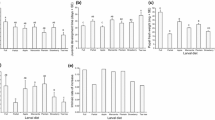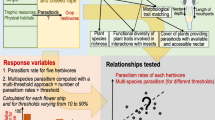Abstract
Trait-mediated indirect effects can have important effects on food web dynamics but are still poorly understood in the field. In a previous population cage study of a small community of aphids and an aphid natural enemy it was found that a trait-mediated indirect effect involving the natural enemy’s behaviour was key to understanding community persistence. Here evidence is presented that a related phenomenon involving some of the same species occurs in the field. Surveys showed that two species of aphid (Acyrthosiphon pisum and Megourella purpurea) tended to share a host plant with a third generally unpalatable species (Megoura viciae) more often than expected by chance. Further evidence suggested this was not due to differential plant suitability or location, but to a positive effect of M. viciae on the performance of the other two species. To test this, field experiments were set up comparing the size and persistence of A. pisum colonies sharing or not sharing a plant individual with M. viciae colonies. A. pisum colonies tended to be larger and persisted for a longer period of time in the presence of M. viciae, an effect that was significant for small colonies exposed to many predators. When protected from predation the presence of M. viciae had no effect on A. pisum colonies. The positive effects of M. viciae on A. pisum is thus likely to be natural-enemy mediated rather than plant mediated. How predation by Syrphidae, the major group observed in the study, is affected by M. viciae is discussed.



Similar content being viewed by others
References
Abrams PA (1983) Arguments in favor of higher-order interactions. Am Nat 121:887–891
Abrams PA (1987) On classifying interactions between populations. Oecologia 73:272–281
Abrams PA, Vos M (2003) Adaptation, density dependence and the responses of trophic level abundances to mortality. Evol Ecol Res 5:1113–1132
Almohamad R, Verheggen FJ, Francis F, Haubruge E (2007) Predatory hoverflies select their oviposition site according to aphid host plant and aphid species. Entomol Exp App 125:13–21. doi:10.1111/j.1570-7458.2007.00596.x
Andow DA (1991) Vegetational diversity and arthropod population response. Annu Rev Entomol 36:561–586
Beckerman AP, Uriarte M, Schmitz OJ (1997) Experimental evidence for a behavior-mediated trophic cascade in a terrestrial food chain. Proc Natl Acad USA 94:10735–10738
Bolker B, Holyoak M, Krivan V, Rowe L, Schmitz O (2003) Connecting theoretical and empirical studies of trait-mediated interactions. Ecology 84:1101–1114
Bonsall MB, Hassell MP (1997) Apparent competition structures ecological assemblages. Nature 388:371–373
Borer ET, Seabloom EW, Shurin JB, Anderson KE, Blanchette CA, Broitman B, Cooper SD, Halpern BS (2005) What determines the strength of a trophic cascade? Ecology 86:528–537
Chase JM, Abrams PA, Grover JP, Diehl S, Chesson P, Holt RD, Richards SA, Nisbet RM, Case TJ (2002) The interaction between predation and competition: a review and synthesis. Ecol Lett 5:302–315
Crawley MJ (2007) The R book, 1st edn. Wiley, Chichester
Dambacher JM, Li HW, Rossignol PA (2002) Relevance of community structure in assessing indeterminacy of ecological predictions. Ecology 83:1372–1385
Dicke M, van Poecke RMP, de Boer JG (2003) Inducible indirect defence of plants: from mechanisms to ecological functions. Basic Appl Ecol 4:27–42
Dixon AFG (1958) The escape responses shown by certain aphids to the presence of the coccinellid Adalia decempunctata (L.). Trans R Entomol Soc 110:319–334
Duffy JE (2002) Biodiversity and ecosystem function: the consumer connection. Oikos 99:201–219
Duffy JE, Richardson JP, France KE (2005) Ecosystem consequences of diversity depend on food chain length in estuarine vegetation. Ecol Lett 8:301–309. doi:10.1111/j.1461-0248.2005.00725.x
Ferrari J, Via S, Godfray HCJ (2008) Population differentiation and genetic variation in performance on eight hosts in the pea aphid complex. Evolution 62:2508–2524. doi:10.1111/j.1558-5646.2008.00468.x
Goudard A, Loreau M (2008) Nontrophic interactions, biodiversity, and ecosystem functioning: an interaction web model. Am Nat 171:91–106. doi:10.1086/523945
Griffen BD, Byers JE (2006) Partitioning mechanisms of predator interference in different habitats. Oecologia 146:608–614. doi:10.1007/s00442-005-0211-4
Hillebrand H, Cardinale BJ (2004) Consumer effects decline with prey diversity. Ecol Lett 7:192–201. doi:10.1111/j.1461-0248.2004.00570.x
Holt RD (1977) Predation, apparent competition, and structure of prey communities. Theor Popul Biol 12:197–229
Holt RD, Lawton JH (1994) The ecological consequences of shared natural enemies. Annu Rev Ecol Syst 25:495–520
Holt RD, Grover J, Tilman D (1994) Simple rules for interspecific dominance in systems with exploitative and apparent competition. Am Nat 144:741–771
Kratina P, Vos M, Anholt BR (2007) Species diversity modulates predation. Ecology 88:1917–1923
Kunert G, Weisser WW (2003) The interplay between density- and trait-mediated effects in predator-prey interactions: a case study in aphid wing polymorphism. Oecologia 135:304–312. doi:10.1007/s00442-003-1185-8
Kunert G, Otto S, Rose USR, Gershenzon J, Weisser WW (2005) Alarm pheromone mediates production of winged dispersal morphs in aphids. Ecol Lett 8:596–603. doi:10.1111/j.1461-0248.2005.00754.x
LeBrun EG (2005) Who is the top dog in ant communities? Resources, parasitoids, and multiple competitive hierarchies. Oecologia 142:643–652. doi:10.1007/s00442-004-1763-4
Leibold MA (1989) Resource edibility and the effects of predators and productivity on the outcome of trophic interactions. Am Nat 134:922–949
Montoya JM, Pimm SL, Sole RV (2006) Ecological networks and their fragility. Nature 442:259–264. doi:10.1038/nature04927
Müller CB, Godfray HCJ (1999) Predators and mutualists influence the exclusion of aphid species from natural communities. Oecologia 119:120–125
Nelson EH (2007) Predator avoidance behavior in the pea aphid: costs, frequency, and population consequences. Oecologia 151:22–32. doi:10.1007/s00442-006-0573-2
Palomo G, Botto F, Navarro D, Escapa M, Iribarne O (2003) Does the presence of the sw atlantic burrowing crab Chasmagnathus granulatus Dana affect predator-prey interactions between shorebirds and polychaetes? J Exp Mar Biol Ecol 290:211–228
Peacor SD, Werner EE (2004) How dependent are species-pair interaction strengths on other species in the food web? Ecology 85:2754–2763
Pinheiro J, Bates DM (2000) Mixed effects models in S and S-plus. Springer, New York
Polis GA, Strong DR (1996) Food web complexity and community dynamics. Am Nat 147:813–846
Prasad RP, Snyder WE (2006) Diverse trait-mediated interactions in a multi-predator, multi-prey community. Ecology 87:1131–1137
Schmitz OJ, Beckerman AP, Obrien KM (1997) Behaviorally mediated trophic cascades: effects of predation risk on food web interactions. Ecology 78:1388–1399
Schmitz OJ, Hamback PA, Beckerman AP (2000) Trophic cascades in terrestrial systems: a review of the effects of carnivore removals on plants. Am Nat 155:141–153
Shiojiri K, Takabayashi J, Yano S, Takafuji A (2001) Infochemically mediated tritrophic interaction webs on cabbage plants. Popul Ecol 43:23–29
Smith RA, Mooney KA, Agrawal AA (2008) Coexistence of three specialist aphids on common milkweed, Asclepias syriaca. Ecology 89:2187–2196
Steiner CF (2001) The effects of prey heterogeneity and consumer identity on the limitation of trophic-level biomass. Ecology 82:2495–2506
Strong DR (1992) Are trophic cascades all wet—differentiation and donor-control in speciose ecosystems. Ecology 73:747–754
R Development Core Team (2007). R: a language and environment for statistical computing. Foundation for statistical computing, Vienna. ISBN 3-900051-07-0. http://www.R-project.org
van Veen FJF, van Holland PD, Godfray HCJ (2005) Stable coexistence in insect communities due to density- and trait-mediated indirect effects. Ecology 86:3182–3189
van Veen FJF, Morris RJ, Godfray HCJ (2006) Apparent competition, quantitative food webs, and the structure of phytophagous insect communities. Annu Rev Entomol 51:187–208. doi:10.1146/annurev.ento.51.110104.151120
van Veen FJF, Müller CB, Pell JK, Godfray HCJ (2008) Food web structure of three guilds of natural enemies: predators, parasitoids and pathogens of aphids. J Anim Ecol 77:191–200
Vos M, Berrocal SM, Karamaouna F, Hemerik L, Vet LEM (2001) Plant-mediated indirect effects and the persistence of parasitoid-herbivore communities. Ecol Lett 4:38–45
Vos M, Vet LEM, Wackers FL, Middelburg JJ, van der Putten WH, Mooij WM, Heip CHR, van Donk E (2006) Infochemicals structure marine, terrestrial and freshwater food webs: implications for ecological informatics. Ecol Informatics 1:23–32. doi:10.1016/j.ecoinf.2005.06.001
Xiong HZ, Dong HF (1992) Experiments on rearing and greenhouse release of the larvae of Metasyrphus corollae (Dip.: Syrphidae). Chin J Biol Control 8:6–9
Acknowledgements
This work was funded by the UK Natural Environment Research Council and complies with UK law.
Author information
Authors and Affiliations
Corresponding author
Additional information
Communicated by Wolfgang Weiser.
Electronic supplementary material
Below is the link to the electronic supplementary material.
Rights and permissions
About this article
Cite this article
van Veen, F.J.F., Brandon, C.E. & Godfray, H.C.J. A positive trait-mediated indirect effect involving the natural enemies of competing herbivores. Oecologia 160, 195–205 (2009). https://doi.org/10.1007/s00442-009-1288-y
Received:
Accepted:
Published:
Issue Date:
DOI: https://doi.org/10.1007/s00442-009-1288-y




